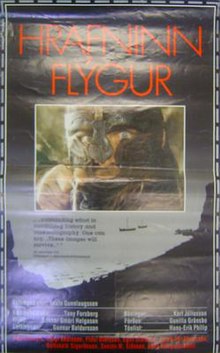
Back Hrafninn Flýgur Welsh Når ravnen flyver Danish Der Flug des Raben German Hrafninn flýgur Basque Le Vol du corbeau (film) French Hrafninn flýgur Icelandic Ravnen flyr NB Hrafninn flýgur Portuguese Полёт ворона Russian Korpen flyger Swedish
| Hrafninn Flýgur | |
|---|---|
 Original theatrical release poster | |
| Directed by | Hrafn Gunnlaugsson |
| Written by | Hrafn Gunnlaugsson Bo Jonsson |
| Produced by | Bo Jonsson |
| Starring | Jakob Þór Einarsson Edda Björgvinsdóttir Helgi Skúlason Egill Ólafsson Flosi Ólafsson Gotti Sigurdarson |
| Cinematography | Tony Forsberg |
| Edited by | Hrafn Gunnlaugsson |
| Music by | Hans-Erik Philip (original version) Harry Manfredini (US version) |
Production companies | Viking Film Svenska Filminstitutet (SFI) Icelandic Film Center |
| Distributed by | Svenska Filminstitutet |
Release date |
|
Running time | 109 minutes |
| Countries | Iceland Sweden |
| Language | Icelandic |
When the Raven Flies (original Icelandic: Hrafninn flýgur ()) is a 1984 Icelandic-Swedish adventure film written and directed by Hrafn Gunnlaugsson. The story is set in Viking Age Iceland. The film was selected as the Icelandic entry for the Best Foreign Language Film at the 57th Academy Awards, but was not accepted as a nominee.[1] In 2016, online newspaper Kjarninn voted it as the best Icelandic film of all time.[2]
Although mainly a tale of personal revenge, When the Raven Flies bears some resemblance to the classic Akira Kurosawa film Yojimbo and A Fistful of Dollars of Sergio Leone, sharing common plot events, characters and action sequences.,[3] which itself drew inspiration from Dashiell Hammett's Red Harvest. Gunnlaugsson also drew inspiration from the Sagas of Icelanders and aimed to deconstruct the Viking stereotypes, replacing them with more authentic portrayals of the Viking era.[4]
When the Raven Flies is the first film of the Raven Trilogy (also known as the Viking Trilogy) that consists of three Viking films: When the Raven Flies (1984, usually known as simply The Raven or Revenge of the Barbarians), In the Shadow of the Raven (1987, original Icelandic title: Í skugga hrafnsins) and Embla (1991, original Icelandic title: Hvíti víkingurinn), which is a director's cut of The White Viking.
- ^ Margaret Herrick Library, Academy of Motion Picture Arts and Sciences
- ^ Kristinn Haukur Guðnason (17 June 2016). "Tíu bestu íslensku kvikmyndirnar". Kjarninn.is. Archived from the original on 18 June 2016. Retrieved 23 December 2021.
- ^ Nestingen, Andrew K.; Elkington, Trevor Glen (2005). Transnational Cinema in a Global North: Nordic Cinema in Transition. pp. 341–349. ISBN 9780814332436.
- ^ Sundholm, John; Thorsen, Isak; Andersson, Lars Gustaf; Hedling, Olof; Iversen, Gunnar; Møller, Birgir Thor (20 September 2012). Historical Dictionary of Scandinavian Cinema. p. 205. ISBN 9780810878990.